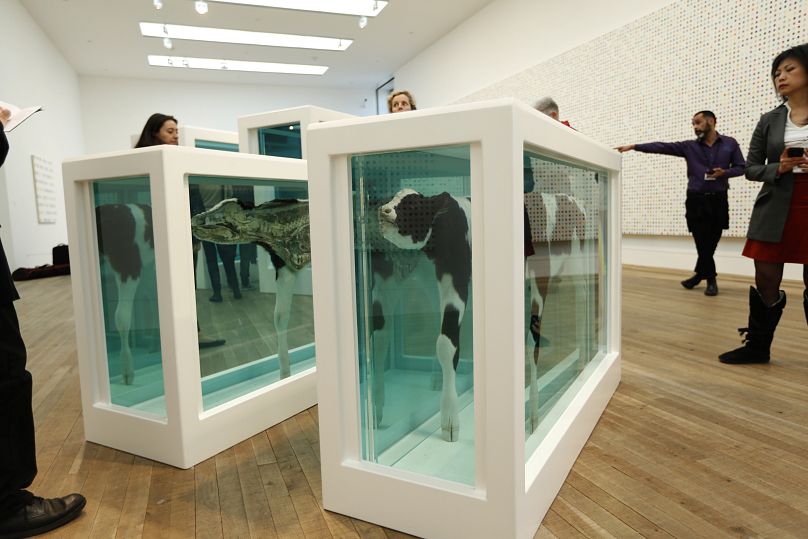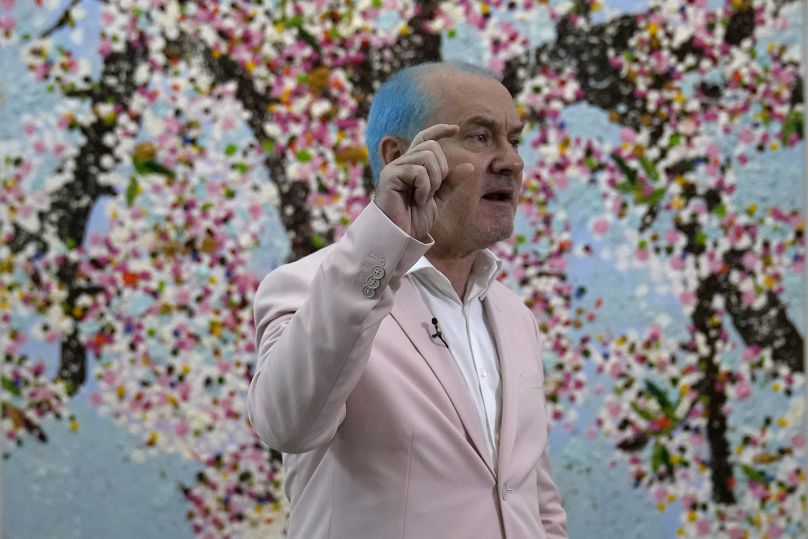Has the Turner Prize-winning artist misled the public about the creation dates of three famous artworks?
Acclaimed and controversial British artist Damien Hirst is in deep water… or perhaps deep formaldehyde, as he has been accused of misrepresenting the dates he created famous artworks.
A Guardian investigation has found that artworks Hirst’s company had dated in the 1990s were actually made in 2017. The inquiry covered three of the artist’s works in preserving dead animals in formaldehyde – a dove, a shark, and two calves – were annotated to imply they were from his most notable era.
Hurst burst onto the art scene in the 90s and made a name for himself as part of the Young British Artists (YBAs) that brought an anarchic touch to the field. Much of his first famous works were of dead animals preserved in different states.
‘The Physical Impossibility of Death in the Mind of Someone Living’ from 1991 is perhaps his most well-known piece and features an entire tiger shark in a clear case filled with formaldehyde. In 1995, Hirst won the Turner Prize for his work.
In 2017, Hirst’s work was exhibited in Gagosian’s Hong Kong art gallery in a show called ‘Visual Candy and Natural History’ that was framed as an exhibition of his work “from the early to mid-1990s”. It was at this show that the three newly made pieces made their debut.
The three works were made by Hirst’s employees in a workshop in Dudbridge, Gloucestershire earlier that year.
All three works imply that they are from the 90s era of Hirst’s work in their titles. The work including the two calves is called ‘Cain and Abel, 1994’, the one featuring the dove is called ‘Dove, 1999’, and the piece with a trisected shark is titled ‘Myth Explored, Explained, Exploded, 1993-1999’.
Dates and displays
‘Dove, 1999’ is believed to have been sold around the time of the original Hong Kong exhibition, while the other two works have been exhibited around the world.
‘Myth Explored, Explained, Exploded, 1993-1999’ and ‘Cain and Abel, 1994’ have always been displayed consistently beside 1990s dates with the shark piece now on show at the Munich Museum of Urban and Contemporary Art.
In response to the Guardian’s questions, Hirst’s company Science Ltd said: “Formaldehyde works are conceptual artworks and the date Damien Hirst assigns to them is the date of the conception of the work. He has been clear over the years when asked what is important in conceptual art; it is not the physical making of the object or the renewal of its parts, but rather the intention and the idea behind the artwork.”
Comments from Hirst’s lawyers have accepted that while many of his works are dated according to their physical creation, and despite any industry norms, that the “dating of artworks, and particularly conceptual artworks, is not controlled by any industry standard,” and “Artists are perfectly entitled to be (and often are) inconsistent in their dating of works.”
However, the investigation has also suggested Hirst has purposely misled the public to thinking the works are dated from the 1990s, noting the artist’s comments in 2017 on the three works that “I prefer them now to when I made them,” alongside evidence that Science Ltd workers were instructed to artificially age the structures. Although Hirst’s lawyers have rebutted that this is merely part of his “artistic process”.
Hirst’s work is not publicly categorised, so galleries and auctioneers are entirely reliant on Science Ltd for information.













